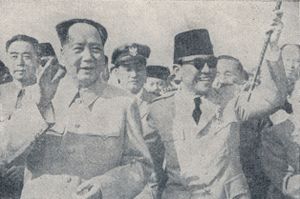العلاقات الإندونيسية الصينية
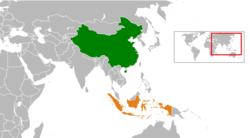 | |
الصين |
إندونيسيا |
|---|---|
العلاقات الإندونيسية الصينية هي العلاقات الثنائية بين جمهورية الصين الشعبية و إندونيسيا. The relations between two nations have been ongoing for centuries, and were officially recognized in 1950. However the diplomatic relationship between the two states was suspended in 1967, the same year Indonesian capitalist dictator Suharto came to power as acting president after Sukarno's forced resignation, and then resumed in 1990. China has an embassy in Jakarta and consulates in Surabaya and Medan, while Indonesia has an embassy in Beijing and consulates in Guangzhou, Shanghai and Hong Kong. Both countries are among the largest nations in Asia in terms of both area and population, China is the most populous nation on earth, while Indonesia has the 4th largest population in the world. Both nations are the members of APEC and G-20 major economies.
According to a 2014 BBC World Service Poll, the opinion of China among Indonesians remains strongly positive and stable, with 52% of positive view compared to 28% expressing a negative view.[1]
. . . . . . . . . . . . . . . . . . . . . . . . . . . . . . . . . . . . . . . . . . . . . . . . . . . . . . . . . . . . . . . . . . . . . . . . . . . . . . . . . . . . . . . . . . . . . . . . . . . . . . . . . . . . . . . . . . . . . . . . . . . . . . . . . . . . . . . . . . . . . . . . . . . . . . . . . . . . . . . . . . . . . . . .
التاريخ

The relations between imperial China and ancient Indonesia commenced during the 7th century, possibly earlier. Indonesia was part of the maritime Silk Road connecting China with India and the Arab world. Numerous Chinese ceramics were discovered throughout Indonesia, suggesting ancient trade links between both countries. The National Museum of Indonesia has one of the best and the most complete collections of Chinese ceramics discovered outside of China, dated from the Han, Tang, Song, Yuan, Ming and Qing dynasties, spanning for almost two millennia.[2] This particular collection provides a good insight into Indonesia's maritime trade over the centuries. Research indicates that the Chinese sailed to India via Indonesia as early as Western Han period (205 BC to 220 AD) as a part of the maritime silk road and firm trade relations were subsequently established.[3] Traditionally, the Indonesian archipelago, identified by ancient Chinese geographer as Nanyang, was the source of spices such as cloves, cubeb, and nutmeg, raw materials such as sandalwood, gold and tin, as well as exotic rare items such as ivory, rhino horn, tiger fur and bone, exotic birds and colorful feathers. While the fine silk and ceramics of China was sought by ancient Indonesian kingdoms. Indonesia also played some role in the expansion of Buddhism from India to China. A Chinese monk, I-Tsing, visited Srivijaya in 671 for 6 months during his mission to acquire sacred Buddhist texts from India.[4][5] Other Chinese accounts and chronicles also mention several ancient states in Indonesia today. Chinese records mentioned about Kunlun sailors, presumably Cham or Malays sailors, that sailed and traded many products across ports in Southeast and South Asia. The Malay sailors are most probably hailed from Srivijayan empire in Sumatra. Ancient Indonesian sailors seems to actively sought trade around Southeast Asia and as far as China and India.[6] Since I-Tsing, numbers of Chinese travelers such as Chou Ju-kua began to visit and wrote about the Indonesian archipelago.
Most ancient Chinese-Indonesia relations were trade-motivated and throughout their shared history, most were harmonious and peaceful, with one exception. In 1293, Kublai Khan of Yuan dynasty sent a massive expedition of 1,000 ships to Java to punish the defiant king Kertanegara of Singhasari.[7] The naval expedition however, was a failure as Java rose to be Majapahit empire instead. Maritime empires such as Srivijaya, Majapahit, and later Malacca sought trade permits to establish relations with lucrative Chinese markets. The numbers of Chinese immigrants and Chinese influences in the archipelago reached a new height, with the massive Ming dynasty naval expedition led by admiral Zheng He that visited Java, Sumatra, and the Malay peninsula in early the 15th century. Zheng He's translator Ma Huan wrote a detailed description of Majapahit and where the king of Java lived.[8] The report was composed and collected in Yingya Shenglan, which provides a valuable insight on the culture, customs, also various social and economic aspects of Chao-Wa (Java) during Majapahit period.[9] The Chinese naval expedition contributed to the establishment of overseas Chinese settlements in Indonesia, such as Semarang, Tuban and Lasem which have had significant Chinese populations since Majapahit era.
During the colonial Dutch East Indies Company and Dutch East Indies era, significant Chinese settlers began to fill labor needs and seek a new life in the Indonesian archipelago. Most of Chinese Indonesian immigrants came from the provinces of Southern China, such as Fujian and Guangdong. Significant Chinese settlements were established in West Kalimantan, the east coast of Sumatra, and the northern coast of Java.
After the Indonesia's independence in 1945 and the acknowledgement of its sovereignty from the Dutch in 1949, Indonesia established political relations with China (previously with جمهورية الصين ولاحقاً مع جمهورية الصين الشعبية) في 1950.[10] في الواقع، فقد كانت إندونيسيا أول بلد في جنوب شرق آسيا يؤسس علاقات دبلوماسية رسمية مع الصين الشعبية.[11] أثناء ادارة سوكارنو، تمتعت الصين وإندونيسيا بعلاقات قوية. ففي عقدي 1950 إلى 1960 كان للحزب الشيوعي الصيني على علاقة قوية مع نظيره الإندونيسي. إلا أن سوكارنو أصدر المرسوم الرئاسي (سيء الذِكر) رقم 10 في 1959، الذي سلب “المواطنين الأجانب” من حق ادارة أعمال التجزئة في المناطق الريفية. ولما كان الصينيون يشكلون نحو 90% من الأعمال التي يملكها أجانب في إندونيسيا، فإن مرسوم سوكارنو كان يُرى على أن له دوافع عرقية. بينما، تقنياً فإن المرسوم أشار فقط إلى “المواطنين الأجانب”، فإنه في الواقع استهدف العرق الصيني، بما في من يملكون الجنسية الإندونيسية. في السنوات الست التالية، نتج عن المرسوم رحيل نحو مائة ألف من الصينيين من إندونيسيا إلى الصين، التي كانت في وضع اقتصادي عصيب. وقامت الحكومة الصينية آنذاك بإنشاء بلدات مثل كامپوڠ بالي نانسان Kampung Bali Nansan، التي سُميت "بالي الصينية" لاستيعاب أولئك المهاجرين في مقاطعات فوجيان، وگوانگدونگ وهاينان الجنوبية.[12]
إلا أن بعد أسفر الانقلاب الشيوعي في 1965 الفاشل عن سقوط سوكارنو وصعود سوهارتو في 1967، قطعت إندونيسيا العلاقات الدبلوماسية، وإصرارها على أن الصين الشيوعية كانت مسئولة جزئياً عن الانقلاب، maintaining that Communist China was partly responsible behind the coup.[13] The diplomatic relations however, were restored and resumed in 1990 resulting in the normalization of China-Indonesia diplomatic relations.
تاريخ العلاقات السياسية
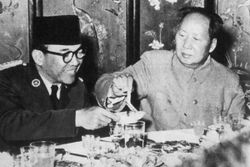
China and Indonesia established diplomatic relations on April 13, 1950, which were suspended on October 30, 1967 due to the occurrence of the September 30 event of 1965, the subsequent 1967 seizure of power by Lt. General Suharto which appointed him to the office of acting president, the stepping down of President Sukarno, and the eventual beginning of the capitalist 'New Order', which, under Suharto's presidency, would last thirty-one years.
Country comparison
| Country | ||
|---|---|---|
| Area | 9,596,961 square kilometres (3,705,407 sq mi) | 1,904,569 square kilometres (735,358 sq mi) |
| Population | 1,403,500,365 (2016) | 261,115,456 (2016) |
| Pop. density | 145 inhabitants per square kilometre (380/sq mi) | 138 inhabitants per square kilometre (360/sq mi) |
| Capital | Beijing | Jakarta |
| Largest city | Shanghai – 24,183,300 (34,000,000 Metro) | Jakarta – 10,075,310 (30,214,303 Metro) |
| Government | Unitary one-party socialist republic | Unitary presidential constitutional republic |
| Language(s) | Standard Chinese (official) | Indonesian (official) |
| Religions | 73.5% Irreligious/Folk, 15.8% Buddhism, 2.5% Christianity, 0.4% Islam | 87.2% Islam, 9.9% Christianity, 1.7% Hinduism, 0.7% Buddhism, 0.2% Confucianism |
| Ethnic groups | 91.5% Han, 1.3% Zhuang, 0.9% Manchu, 0.8% Uyghur, 0.8% Hui, 0.7% Miao, 0.6% Yi, 0.6% Tujia, 0.5% Mongol, 0.4% Tibetan, etc. | 42.6% Javanese, 15.4% Sundanese, 3.4% Malays, 3.3% Madurese, 3% Batak, 2.7% Minangkabau, 2.5% Betawi, 2.4% Bugis, etc. |
| GDP | $13.457 trillion (nominal, 2018); $25.313 trillion (PPP, 2018) | $1.074 trillion (nominal, 2018); $3.492 trillion (PPP, 2018) |
| GDP per capita | $9,633 (nominal, 2016); $18,119 (PPP, 2018) | $4,051 (nominal, 2018); $13,162 (PPP, 2018) |
| GDP growth rate | 6.9% (2017) | 5.1% (2017) |
| Main industries | Mining, metal processing, armaments, textiles | Palm oil, coal, petroleum, textiles |
| Labor force | 803 million (2017) | 125 million (2016) |
| HDI | 0.752 (High) | 0.694 (Medium) |
Trade and investment

Trade between China and Indonesia is on the rise, especially after the implementation of ACFTA since early 2010. Indeed, while in 2003 trade between Indonesia and China reached only US$3.8 billion, in 2010 it multiplied almost 10 times and reached US$36.1 billion.[14] China's transformation into Fastest growing country in the 21st century has led to an increase of foreign investments in the bamboo network, a network of overseas Chinese businesses operating in the markets of Southeast Asia that share common family and cultural ties.[15][16] However the free trade with China has caused much anxiety in Indonesia, since inflows of cheap products from China could harm Indonesian industry. Indonesian private sector and civil society organizations vigorously lobbied the Indonesian government and members of parliament, insisting that Indonesia should either pull out of the agreement or renegotiate its terms with Beijing.
Culture
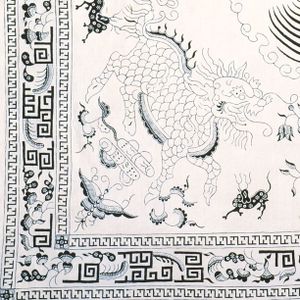
Since ancient times, Indonesian culture began to absorb many aspects of Chinese elements, such as Chinese origin loanwords in Indonesian that mostly are terms of all things Chinese, cuisine, to art and crafts such as Javanese Batik Pesisiran (coastal batik) that demonstrate Chinese images such as Chinese cloud, phoenix, dragon, qilin, to peony flower. Chinese settlers began to settle in Indonesian coastal cities as early as Srivijaya (c. 7th century) and Majapahit (c. 14th century) period. And later accelerated during Dutch East Indies Company era (c. 17th century). These Chinese immigrants brought with them Chinese culture of their homeland, intermarried with local women and created the hybrid peranakan culture, still observable today in some of Indonesian cities and neighboring Malaysia and Singapore. Today, there are around 2,832,510 Chinese Indonesians according to 2010 census, which formed 1.20% of the Indonesian population.
State visits
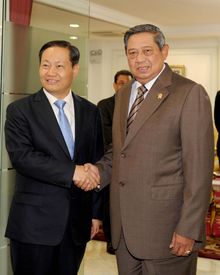
The bilateral relations developed gradually since the resumption of diplomatic relations of the two countries. Since the resumption of diplomatic ties between the two countries, President Yang Shangkun (in 1991), Chairman of NPC Standing Committee Qiao Shi (in 1993) and Vice Premier Zhu Rongji (in 1996), Vice President Hu Jintao (in 2000) of China visited Indonesia. President Suharto (in 1990), Speaker of Parliament Suhud (in 1991), Vice President Sudarmono(in 1992) and Chairman of the Supreme Advisory Council Sudomo (in 1997) visited China. President Jiang Zemin of China paid a state visit to Indonesia in November 1994 after he attended the second APEC Leaders' Informal Meeting. In December 1999, President K.H. Abdurrahman Wahid of Indonesia paid a state visit to China, during which the two countries issued a joint press communiqué. In July 2000, Vice President Hu Jintao visited Indonesia at the invitation of Vice President Megawati.
In November 2001, Premier Zhu Rongji paid a visit to Indonesia. In March 2002, Indonesian President Megawati Sukarnoputri paid a state visit to China. In April, President Abdurrahman Wahid of the Indonesian People's Consultative Assembly visited China. In September, Chairman Li Peng of the NPC paid an official friendly visit to Indonesia.
Tiongkok
Tiongkok (中國) is an Indonesian term for China and the Chinese meaning "middle kingdom". It has origins in the Min Nan dialect (the local dialect of Southern Fujian) of the word Zhongguo, in Mandarin. The word—in its Romanized form (Tiongkok)-- was used in Indonesian by the Indonesian government to refer to China up until 1972[17] but its use ceased following a period of hostile relations in the 1960s. The authoritarian, anti-Chinese New Order government mandated the replacement of the term Tiongkok, as well as Tionghoa (中華), with "Cina". Many Chinese Indonesians felt that the term (in reference to them) was derogatory and racist, connoting "backwardness, humiliation, queues and bound feet".[18] After the fall of President Suharto in 1998, the use of Tiongkok has seen a re-emergence.[19]
. . . . . . . . . . . . . . . . . . . . . . . . . . . . . . . . . . . . . . . . . . . . . . . . . . . . . . . . . . . . . . . . . . . . . . . . . . . . . . . . . . . . . . . . . . . . . . . . . . . . . . . . . . . . . . . . . . . . . . . . . . . . . . . . . . . . . . . . . . . . . . . . . . . . . . . . . . . . . . . . . . . . . . . .
South China Sea disputes
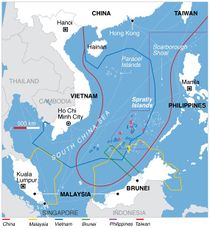
Despite Indonesia's position as a non-claimant state in the South China Sea dispute,[20] two countries were inevitably involved in this territorial dispute; as parts of China's unilaterally claimed nine-dash line is intersecting with Indonesia's exclusive economic zone near Natuna islands. Although China has acknowledged Indonesia's sovereignty over Natuna islands, China argues that the waters around Natuna islands are Chinese "traditional fishing grounds". Indonesia quickly dismiss this claim and believes it has no legal basis.[21] Two countries were involved in clashes near Natuna islands; as Indonesian maritime authority that tried to capture a Chinese trawler accused for illegal fishing was prevented by Chinese coast guard boat.[22] Indonesia insists to prosecute Chinese trawler crew, despite Beijing's demand to release them. An Indonesian official said that the "traditional fishing grounds" was not recognised under the UNCLOS. This incident prompted Indonesian military to increase its presence in Natuna area.[23] On 23 June 2016, Indonesian President Joko Widodo visited Natuna islands on a warship, this was meant to send a "clear message" that Indonesia was "very serious in its effort to protect its sovereignty".[24]
Following the Permanent Court of Arbitration ruling on 12 July 2016, Indonesia called on all parties involved in the territorial dispute to exercise self-restraint and to respect applicable international laws.[25]
انظر أيضاً
- Chinese Indonesian (Tionghoa)
- العلاقات الخارجية لجمهورية الصين الشعبية
- العلاقات الخارجية لإندونيسيا
- Bamboo network
- Anti-Chinese sentiment in Indonesia
References
- ^ 2014 World Service Poll BBC
- ^ "Museum in Jakarta". Archived from the original on 2010-03-29.
- ^ Rosi, Adele (1998). Museum Nasional Guide Book. Jakarta: PT Indo Multi Media,Museum Nasional and Indonesian Heritage Society. p. 54.
- ^ Munoz. Early Kingdoms. p. 122.
- ^ Zain, Sabri. "Sejarah Melayu, Buddhist Empires".
- ^ Sigfried J. de Laet, Joachim Herrmann, ed. (1996). History of Humanity: From the seventh century B.C. to the seventh century A.D., Volume 3 dari History of Humanity Volume 3 dari History of Humanity: Scientific and Cultural Development, Volume 3 dari History of Humanity: Scientific and Cultural Development. From the Third Millennium to the Seventh Century BC, Routledge reference. UNESCO. p. 442. ISBN 9789231028120.
- ^ Weatherford, Jack (2004), Genghis khan and the making of the modern world, New York: Random House, p. 239, ISBN 0-609-80964-4.
- ^ Ma Huan (1970) [1433]. Ying-yai Sheng-lan (瀛涯胜览) The Overall Survey of the Ocean's Shores. Hakluyt Society (in Chinese). translated by J.V.G Mills. Cambridge University Press. ISBN 9780521010320.
{{cite book}}: CS1 maint: unrecognized language (link) - ^ Ma Huan; JVG Mills (1970). "Ying-yai Sheng-lan, The Overall Survey of the Ocean's Shores" (PDF). Washington.edu. pp. 86–97 (Country of Chao-Wa).
- ^ Sukma, Rizal (2009). "Indonesia's Response to the Rise of China: Growing Comfort amid Uncertainties" (PDF). Nids.go.jp: 140. Archived from the original (PDF) on 19 March 2015. Retrieved 25 November 2014.
- ^ Sukma, Rizal (2009). "Indonesia-China Relations: The Politics of Re-engagement". Asian Survey. 49 (4): 591–608. doi:10.1525/as.2009.49.4.591. انظر ص. 591.
- ^ Randy Mulyanto (2019-11-17). "The Chinese who fled Sukarno's Indonesia to build a new Bali under Mao". ساوث تشاينا مورننگ پوست.
- ^ Taomo Zhou, "Ambivalent Alliance: Chinese Policy towards Indonesia, 1960-1965," Cold War International History Project Working Paper No. 67 (August 2013)
- ^ Alexander C. Chandra and Lucky A. Lontoh (2011). "Indonesia – China Trade Relations: The deepening of economic integration amid uncertainty?" (PDF). International Institute for Sustainable Development. Retrieved March 5, 2013.
- ^ Quinlan, Joe (November 13, 2007). "Insight: China's capital targets Asia's bamboo network". Financial Times.
- ^ Murray L Weidenbaum (1 January 1996). The Bamboo Network: How Expatriate Chinese Entrepreneurs are Creating a New Economic Superpower in Asia. Martin Kessler Books, Free Press. pp. 4–8. ISBN 978-0-684-82289-1.
- ^ Sukma, Rizal (1999). Indonesia and China. Routledge. p. 68. ISBN 978-0-415-20552-8.
- ^ Lim, Hermanto; Mead, David (2011). "Chinese in Indonesia: A Background Study" (PDF). SIL International. p. 5.[dead link]
- ^ Quinn, George (2001). The Learner's Dictionary of Today's Indonesian. Allen & Unwin. p. 79. ISBN 978-1-86448-543-1.
- ^ Liza Yosephine (21 June 2016). "Minister echoes Indonesia's stance on South China Sea". The Jakarta Post. Jakarta.
- ^ Klaus Heinrich Raditio, Researching China’s recent behavior and strategy in the South China Sea for his PhD at the University of Sydney (18 July 2016). "Indonesia 'speaks Chinese' in South China Sea". The Jakarta Post.
- ^ "South China Sea: Indonesia summons Chinese ambassador as fishing dispute escalates". The Guardian. 21 March 2016.
- ^ "Indonesia vows to prosecute Chinese trawler crew in South China Sea dispute". The Guardian. 24 March 2016.
- ^ "South China Sea: Indonesian leader visits Natuna Islands amid growing tensions". ABC News. 23 June 2016.
- ^ Liza Yosephine (13 July 2016). "Indonesia's statement on South China Sea dissatisfying: China's experts". The Jakarta Post. Jakarta.
Bibliography
- Cardenal, Juan Pablo; Araújo, Heriberto (2011). La silenciosa conquista china (in الإسبانية). Barcelona: Crítica. pp. 258–261. ISBN 9788498922578.
- Mozingo, David (1976), Chinese Policy toward Indonesia, 1949–1967, Ithaca, N.Y.: Cornell University Press, ISBN 978-0-8014-0921-9.
- Sukma, Rizal (1999), Indonesia and China: The Politics of a Troubled Relationship, London: Routledge, ISBN 978-0-415-20552-8.
- Taomo Zhou (2013), "Ambivalent Alliance: Chinese Policy towards Indonesia, 1960-1965," Cold War International History Project Working Paper No. 67.
وصلات خارجية
- Embassy of People's Republic of China in Republic of Indonesia
- Embassy of the Republic of Indonesia in People's Republic of China
- Communiqué of the government of the People's Republic of China and the Government of the Republic of Indonesia on the resumption of diplomatic relations between the two countries
- Joint Press Communiqué of The People's Republic of China and the Republic of Indonesia
- History of China-Indonesian relations

